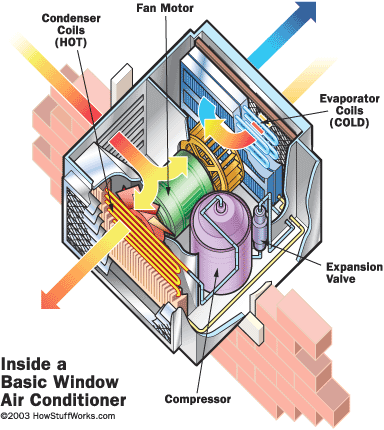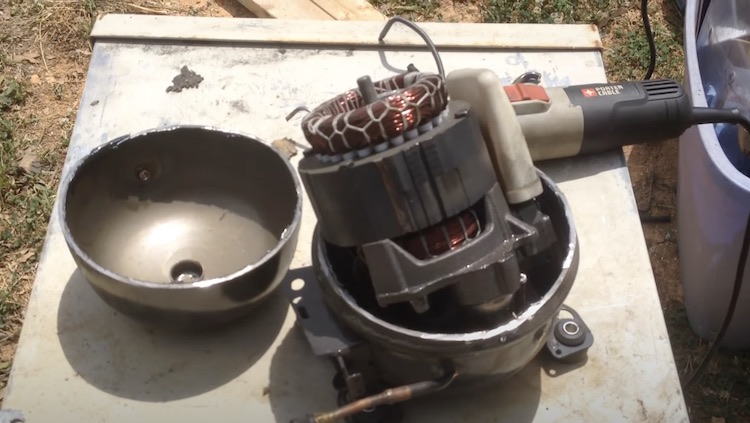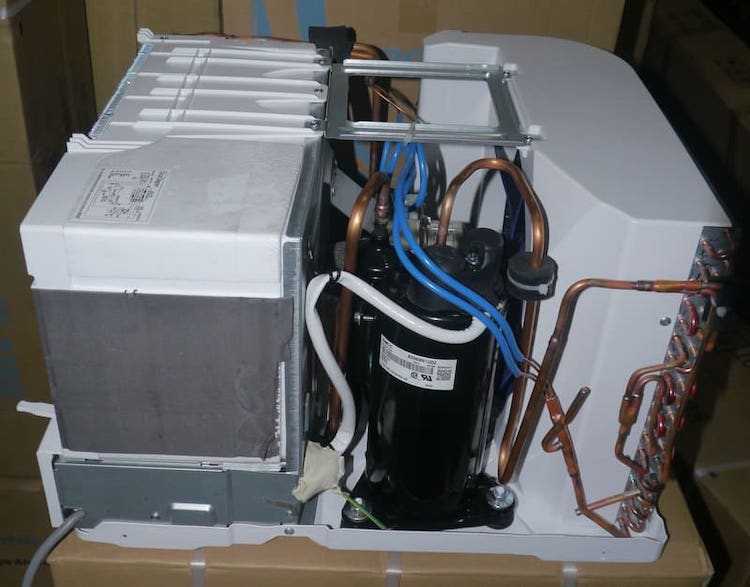So you’ve got your hands on an old, broken AC unit and you want to salvage and recycle/sell as much of it as you can? You’re in the right place! This guide will teach you everything you need to know to successfully extract and sell the most valuable part of the unit – AC compressor scrap.
What is AC Compressor scrap?
Before we turn an AC compressor into cold hard cash, let’s learn a bit about what it is we’ll be recycling.
Compressor scrap is any unusable air conditioning or refrigeration compressor collected for the purpose of selling for scrap. Compressors are generally stored separately from other scrap metals for several reasons. The first is the presence of contaminants such as oil and residual refrigerant gas in the compressor housings. The second is the fact that compressors are sealed units containing several types of metals that require a separate billing system than that applied to a single metal waste material. These metals typically include aluminum, steel, cast iron, and copper.
Air conditioning and refrigeration compressors generally have a very long service life but eventually, break down and become unserviceable. When this occurs, they are generally subject to a compressor recovery system that sees them sold as a specific class of recovered metal known as compressor scrap. As compressors are sealed units and often still contain traces of refrigerant gas and lubricating oil, they are generally stored in separate lots from other scrap metals. In fact, there are many scrap dealers that deal exclusively with compressor scrap; they are generally better equipped to efficiently deal with the unique requirements surrounding compressor disposal.
Parts of an AC unit
An AC compressor is one of the primary components of any air conditioning system. When combined with the condenser and evaporator, you’ve got all the fundamental pieces to take hot, humid air and make it cool and dry. Any AC system is going to have other important components like the blower, the case, the controls, drain lines, etc. but all the magic happens between the condenser and evaporator, and that’s exactly where the compressor sits.

How does a compressor work?
AC systems of all kinds depend on refrigerant. A refrigerant is a fluid that readily converts from liquid to gas and back. There are many, many types of refrigerants. Unfortunately, the majority of the most effective and inexpensive chemicals (called hydroflourocarbons – HFCs) in use as refrigerants are wildly powerful greenhouse gases. These are hundreds to THOUSANDS of times worse for warming than carbon dioxide – bad news. More on that later.
All split-system AC pushes cold, liquid refrigerant into evaporator coils. These coils are exposed to hot air and through heat-exchange cool the air and warm the liquid. This causes some of the refrigerant to transition to gas, and the gas moves into the condenser coils where it cools and converts back to a liquid.
The compressor is the “heart” which pumps the “blood” (refrigerant) around the “body” (the evaporator and condenser coils). Hopefully this metaphor makes everything clear.
What is a compressor made out of?
The inside of a compressor looks a lot like an electric motor. That’s more or less what it is. A lot of copper wire is wrapped in a donut shape around a rotor, and when an electrical current is applied, generates a magnetic field. This field, when applied intermittently at a controlled frequency induces rotation. Science is wild.

Copper is used instead of other metals because it is an excellent conductor, only surpassed by silver. This means electricity flows through is with very little resistance. With low resistance, you can pass a large electrical charge through the material without it heating up or melting, and the more current you have the stronger the magnetic field. The stronger the magnetic field, the stronger the motor operates.
How can you scrap an AC Compressor?
Now that you know what the AC Compressor is, how it works – and most importantly for scraping – what it’s made out of we can discuss the scraping process. Scrap recyclers sometimes take the whole unit and just pay you for that. If you’re not a very handy person with a decent tool kit and high degree of can-do, that’s probably your best bet. However, they’re not going to pay you as much for the entire thing as they will for just the copper inside. They don’t want to have to do the hard work required and then dispose of the non-scrapable materials – that’s YOUR job!
The rest of this guide will give you an overview of what to do.
Repair option?
First and foremost, please only resort to scraping as a last resort. This is a recycling blog, and scraping is definitely useful recycling! However, even better than scraping one or two components out of a system and throwing the rest in the landfill is to repair whatever is broken and continue using or selling a restored, functional device.
Also, I shouldn’t have to say this, but don’t steal AC units just to rip the copper out of it. I know there’s some extremely small percentage of people reading this that are tweakers looking for things they can boost to make some money for their next fix. Please, find help, find God, find something – but don’t find people’s AC units, they need those badly in this warming planet of ours.
Refrigerant Disposal
An important warning before we continue… hopefully you recall what exactly a compressor does in the AC system. It moves refrigerant – one of several types of massively powerful greenhouse gas – between two sets of coils. WE DON’T WANT TO LET THAT REFRIGERANT ESCAPE INTO THE ATMOSPHERE, and in fact, it is illegal to do so.
So what do you do with the refrigerant before removing and disassembling the compressor? Bad news – you’ll need to find an EPA-certified technician to recover the refrigerant. This could potentially involve paying a company to perform the recovery, but not necessarily. Your local sanitation/recycling company may have available resources to handle this for free. If there’s no way to get it out for a reasonable price tag, then usually the scrap recycling facility has a certified technician on site who can remove the refrigerant. In that case you’d likely just sell them the unit whole and they’d take it from there.
Learn more about EPA rules governing refrigerant recovery
Safety considerations
One final warning – I want to be very clear that if you choose to go the more involved route of cutting open the compressor to extract the copper, you do so at your own risk! I have no way to know your technical proficiency with tools, nor could I know important safety-related specifics of every model of compressor. Proceed with caution!
Finding and removing the compressor
Removing the compressor itself is going to be fairly easy. It depends what model AC unit you have, and there are dozens and dozens of different models, each of which may be a little different. If you can’t figure it out within a few minutes of looking at it, your best bet is searching online for the manual of the specific model you have.
Once you’ve got the lid off, identifying the compressor should be fairly simple – it’s going to be the only thing that has any resemblance to a motor, and will have a line going to each of the two sets of coils (evaporator and condenser). That compressor will likely be bolted or screwed to the frame of the AC unit with easily removeable hardware. Again, the manual for the specific model can be helpful here if you can’t quickly figure it out.

Required tools
You’re likely going to need:
- a wrench
- an angle grinder
- a vise (or some other mean to secure the compressor while cutting it open)
- safety glasses
Disassembly Video
The hardware of the AC compressor is going to be protected behind some form of “shell”. Some varieties of AC compressor may have a shell which is bolted together, but more than likely it will be welded shut. You’re going to need to use an angle grinder to cut just above the weld line all the way around the device to get to the inside. Eye protection is a minimum, and you’ll likely want safety gloves. You’re also going to create a lot of sparks, so don’t do this in an environment containing flammable materials.
This is the best video I’ve found on how to cut open and extract the copper wiring from an AC compressor:
How much is AC Compressor scrap worth?
The value of the AC compressor scrap is based entirely on the weight and condition of the metals you are able to extract. And really, the only material likely to be sellable in the compressor is the copper wire in the morot. With clean metal materials, you can expect to earn somewhere between $3-4 per pound for copper wire – my local recycling center was paying $3.40-$3.60 at the time of writing. In general, you could expect less money if the metal is dirty – but it’s unlikely that the copper extracted from inside an electric motor would be dirty.
Keep in mind, prices can vary considerably depending on the specific recycling center(s) in your area. If you have multiple locations nearby it’s definitely worthwhile to call and get a quote.
There may be ~3-5 pounds of copper in the motor – so we can ballpark $14 (plus or minus a few dollars) for each compressor.
Compare that to taking the AC Compressor to the scrap recycler whole, and you might expect to make about $2. If you’re competent to do the work and have some time on your hands, it’s clearly worthwhile to extrac the copper. Especially so if you have multiple compressors that you could work on all in one session.
Where to find recycling companies that buy AC Compressor scrap
It should be very easy to figure out who buys scrap metal near you – just Google it! The search phrase “local scrap metal recycler” should automatically pull up a list of all the options near you. This assumes that you’re not using a VPN and Google knows where you are. If that’s not the case, just add your city name on the end.
One thing to keep in mind when you visit a scrap yard is that different states have different requirements for tracking. California probably has the strictest rules regarding the sale of scrap metal. You must provide your car’s license plate number, fingerprints, and photo ID – and you have to wait 3 days before the sale is cleared before they’ll cut you a check. If the value of the scrap is over $20, law enforcement can require the scrap yard to hold any purchased materials for 90 days! These restrictive rules may seem overbearing, but they effective combat scrap theft.
Before recycling scrap for the first time, you’ll want to search for the specific rules in your state or municipality so you’re not surprised.
Conclusion
So that’s it – go forth and make a little money while recycling useful materials for future use!